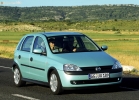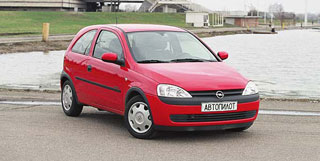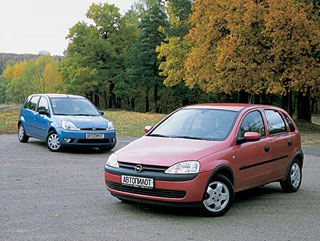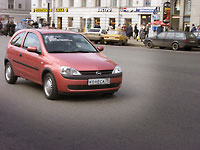Test drive Opel Corsa 5 doors 2000 - 2003 hatchback
Diesel tomorrow
Inexorable statistics indicate that in 2000, 32% of the European car market was occupied by diesel models. The pattern of one of the results of the century is confirmed by ten years of growth of this indicator. In Russia, unlike Western Europe, there are very few diesel cars. The fault of this is the well -known quality of our diesel fuel and the prices for repairs of the fuel pump. Local dealers are well aware of these problems and therefore are diesel, to put it mildly, with a cold.
In Russia, unlike Western Europe, there are very few diesel cars. The fault of this is the well -known quality of our diesel fuel and the prices for repairs of the fuel pump. Local dealers are well aware of these problems and therefore are diesel, to put it mildly, with a cold. In general, we had to go for a cordon to meet with diesel. We have chosen Opel Corsa 1.7 DTI 2000 of the model year, a three -door hatchback on cast discs shod in Dunlop SP Winter Sport M2 (snow was still snow) with a dimension of 185/55 R15. Of course, we had to hear about the incredible qualities of new diesel engines. Before the trip, we were not too lazy to look into the catalog - I was interested in the torque, because it was precisely by this indicator that Western engineers love to trump when they talk about new engines.
 It turned out that the Corsa 1.7 DTI engine (you can break the tongue - in some TDI companies, in others HDI ...) the maximum torque is 165 nm at 1800 rpm. However, it also turned out that each manufacturer solved a diesel problem in his own understanding. Which of the two schemes to choose, with a high -pressure pipeline or with direct injection? Ten years of growth in the popularity of diesel engines - insufficient time for prioritization. The scatter is great and the working volume is the impression that the manufacturers, wanting to quickly bring their engine to the market, scolded their heads in the corners, collecting it from which it would be necessary.
It turned out that the Corsa 1.7 DTI engine (you can break the tongue - in some TDI companies, in others HDI ...) the maximum torque is 165 nm at 1800 rpm. However, it also turned out that each manufacturer solved a diesel problem in his own understanding. Which of the two schemes to choose, with a high -pressure pipeline or with direct injection? Ten years of growth in the popularity of diesel engines - insufficient time for prioritization. The scatter is great and the working volume is the impression that the manufacturers, wanting to quickly bring their engine to the market, scolded their heads in the corners, collecting it from which it would be necessary. Since it is objectively impossible to compare the motors of one working volume, we simply recommend that you look at what is proposed. Turgusel Common Rail Mercedes-Benz A-Class (1.7 L, 95 hp) issues 180 Nm at 1600 rpm, Common Rail Fiat Punto (1.9 liter, 80 hp)- 196 Nm at 1500 rpm, a turbodiesel with direct injection Ford Fiesta (1.8 liters, 75 hp) - 140 nm at 1900 rpm, turbodiesel with direct injection Renault Clio (1.9 liters , 75 hp) - 160 nm at 2000 rpm, turbodiesel with direct injection VW Golf (1.9 liters, 90 hp) - 210 nm at 1900 rpm, Common Rail turbodiesel Citroen and Peugeot (2 l, 90 hp) - 205 Nm at 1900 rpm.
In any case, ten years ago we never dreamed of such characteristics. The trick, however, lies not only and not so much in turbocharged, which affects the power to a greater extent, but in the new power system and four valves on the cylinder. That is, in the filling of the cylinders and again in it.
Previously, diesel engines with a premarler were used on cars, which provided them with more smooth and quiet work. Diesels with direct injection were fifteen percent more economical, but the work was reminiscent of a jack of a hammer. Against the backdrop of the then gasoline engines, the economy of ancestral diesel engines quite satisfied the manufacturers, and no one wanted to rack their heads over the refinement of the heads. Naturally, when gasoline motors pulled up according to characteristics, more effective diesel engines were required ...
If the engineers managed to get rid of the characteristic diesel bass, then not in Corsa 1.7 DTI. But we are not inclined to rush to epithets like a tractor sound, we really like this grunt. At speed, it is masked by the noise of wind and tires, and this trio did not annoy us. There are no vibrations even at idle, which is greatly facilitated by the 4 -point mount of the motor, which is being introduced today and on other models of the company - this decision eliminates the inertial moment that occurs with increasing speed.
The fuel supply in the Corsa motor leads a radial-piston distribution pump, which creates a pressure of about 900 bar. To reduce shock loads in the combustion chamber, the so -called Preliminary injection - a small portion of the fuel is supplied to the chamber in front of the main one. The moment of supply and the required amount of diesel fuel are determined by the central control unit EDC. In addition, the computer monitors the recirculation of the exhaust and boost pressure. It is in our case (a motor with two upper distribution shafts) 0.9 bar.
The Garrett T15 turbocharged with the intercooler used in the Corsa diesel can be found on other Opel models. Of course, he will be different in a different way. Another feature of this engine - the glow of incandescent is located closer to the exhaust valves, which reduces the toxicity of the emission. The path to our diesel is traced from the prototype Opel Corsa Eco 3 (recall the Frankfurt Salon of 1995) - the world's first car with a real consumption of three liters per 100 km.
The turbodiesel assembled at a plant belonging to the ISUZU plant in the Polish town of clouds is perfectly suited to the new Corsa. At the start, the car strives to jump forward, so you need to be more careful in the first gear with the gas pedal. On the second there is a sensitive failure, explained by the inertia of the impudence of the boost. By the time the third is connected, this symptom disappears and makes itself felt when, for example, you decide to vigorously go on a turn on a mountain serpentine - on the edge of the abyss, a desire appears so that after turning on the lower gear, the car slows a little faster. However, she can help with brakes without much risk, since there is an ABS. In general, there are enough electronic things in Corsa. Take at least the Dynamic Safety (DSA) elastic-kinematic scheme. When braking on the surface with heterogeneous grip properties, the angle of convergence of the wheel, which is in a more rough place, automatically increases - this is how the DSA levels the car trend towards rotation or side gluing.
The car prescribes turns, fully justifying Sport Sports on the sidewall. You can move by playing an accelerator - then straightening the trajectory, then, in response to the discharge of gas, screwing into the turn. However, Corsa is a family car, and to a greater extent - a ladies' (in Germany 65% \u200b\u200bof its buyers are women), so its reactions do not have a sharp nature: in order to add a suspension of sports, they only slightly increased the rigidity of the springs and a millimeter - the diameter of stabilizers .
On a straight car accelerates to hundreds in 13.5 seconds. (manufacturer data), and with dignity, without tear, withstands the maximum speed. But, like any car, Corsa 1.7 DTI has favorite modes - 3000 about/min. and the fifth (about 120 km/h) or the fourth (80-90 km/h) transmission.
The steering is equipped with an electric amplifier, which is 2-5% more economical than hydraulic. The electric motor (torque 3.2 nm) is located directly on the steering column. Next to it is a computer that changes the characteristic of the amplifier depending on the speed of the machine and the engine speed. The whole device weighs 8 kg, a kilo less than a hydraulic analogue. By the way, about the economy of the mass - the steering wheel frame is cast from a magnesium alloy.
 Corsa, oddly enough, is not a female interior at all. Nothing to do with powders, cosmetic bags or bottles. Hard male style, and the same colors. The car was created in the atmosphere of the Renaissance of the Bauhaus style - the interiors eliminated the chubby of the steering hub and a false tree. The heart of the steering wheel is unusually flat, which seems to be too large. Nevertheless, the devices do not overlap, and the steering wheel keys (six pieces) of radio machine control and navigation are not confused under the fingers. To get used to them, it takes time, but you can spit, and command with secondary functions in the old fashioned way, from the console. Accident is excluded: the desire to use this or that regime must be proved with convincing pressing.
Corsa, oddly enough, is not a female interior at all. Nothing to do with powders, cosmetic bags or bottles. Hard male style, and the same colors. The car was created in the atmosphere of the Renaissance of the Bauhaus style - the interiors eliminated the chubby of the steering hub and a false tree. The heart of the steering wheel is unusually flat, which seems to be too large. Nevertheless, the devices do not overlap, and the steering wheel keys (six pieces) of radio machine control and navigation are not confused under the fingers. To get used to them, it takes time, but you can spit, and command with secondary functions in the old fashioned way, from the console. Accident is excluded: the desire to use this or that regime must be proved with convincing pressing. How the quality of upholstery has grown in recent years! The only thing that can be advised to those who, like us, decide to check in practice the content of the inscription Sport on the sidewall is to change the steering wheel to Momovsky! The coverage of the standard one is even more or less, but the material is not at all hygroscopic, the perforation is rather conditional. We checked the car in the Swiss Alps, and in the mountains the weather changes with unpredictable speed. A minute ago snow flew into the glass, and suddenly - a dazzling sun. While rebuilding the climatic installation (in Corsa 1.7 DTI it is effective, but without climate control), the hands will become wet.
We pay tribute to things, about which, in general (in relation to modern cars), it is time to stop talking: the excellent visibility and its important component - a feeling of dimensions, a lot of space above the head and under the feet, seized internal door handles, capacious pockets for small things . Do you have many machines in whom these positions are failed by developers?
You get used to the salon as new numbers are rounded on the electronic odometer. Seats with good lateral support, a clear gear switch. The safety belt does not rub the neck, and its lower support moves back and forth - you can adjust the lower loop (at least under the men's beer belly). Wipers - with a function pressed and forgot. The salon lighting ceiling works interestingly: after closing the door, the light fades smoothly.
 The machine was created by an international team with a large share of engineers from South America, which is one of the most important markets for the company. The project started in 1996. The host designer of the body, Brazilian Roberto Rembel, recalled that the activities of the pedantic Germans were pretty flavored with the emotionality of Latinos, and the head of the project Hans Demant was worth the famous effort to defend the principles of clear planning.
The machine was created by an international team with a large share of engineers from South America, which is one of the most important markets for the company. The project started in 1996. The host designer of the body, Brazilian Roberto Rembel, recalled that the activities of the pedantic Germans were pretty flavored with the emotionality of Latinos, and the head of the project Hans Demant was worth the famous effort to defend the principles of clear planning. At the moment, small, 1- and 1.2-liter, motors for Corsa are produced in Aspern under Vienna, 1.4- and 1.8-liter- in Hungarian Zentgottard, diesel engines- as already mentioned- in Poland. The car itself is assembled in Saragos (Spain), Aizenah (Germany) and Azambuye (Portugal).
The great luck of the team is the external architecture of the car. It is not surprising that Corsa looks like a Japanese woman. The author of her design is a Ryussheim Hideo Kadam. We will not bring the coefficient of the circuit: it is incorrect. The Sport version differs from the basic model by the presence of the rear spoiler, wide tires and a body lowered by a 15 mm body, which means a slightly different aerodynamics (in this case, the company is silent about the CT). However, it seems that it is worked out perfectly - judging by the low level of noise and clean glasses.
 What else will the European will evaluate, who will come to the dealer for the turbodiesel Corsa 1.7 DTI? For example, he will surely like that the interior mileage is 30 thousand km. And that the cover of an inflatable airbag is made of material suitable for secondary processing. As well as the fact that the cost of repairs at collisions at speeds up to 15 km/h is extremely low, which is facilitated by cunning box -absorbing structures on which the bumers are strengthened (in addition, at many fastening points, refusing welding, it uses bolt compounds that are better dissipate energy and are easier to replace) ...
What else will the European will evaluate, who will come to the dealer for the turbodiesel Corsa 1.7 DTI? For example, he will surely like that the interior mileage is 30 thousand km. And that the cover of an inflatable airbag is made of material suitable for secondary processing. As well as the fact that the cost of repairs at collisions at speeds up to 15 km/h is extremely low, which is facilitated by cunning box -absorbing structures on which the bumers are strengthened (in addition, at many fastening points, refusing welding, it uses bolt compounds that are better dissipate energy and are easier to replace) ... Text: Denis Orlov
Source: Motor magazine [No. 5/2001]
Video test drive Opel Corsa 5 doors 2000 - 2003
Video Crash tests Opel Corsa 5 doors 2000 - 2003
Test drive Opel Corsa 5 doors 2000 - 2003
Opel Corsa 5 doors 2000 - 2003
Krassh Test: Detailed Information25%
Driver and passengers
9%
Pedestrians
Opel Corsa 5 doors 2000 - 2003
Opel Corsa 5 doors: Detailed information| Corsa 5 doors 2000 - 2003 | |
|---|---|
| Engine |  |
| Transmission |  |
| Control system and suspension |  |
| Brake system |  |
| Air heating and air conditioning |  |
| Launch and charging system |  |
| Electric components and so on |  |
| Corrosion body stability |












